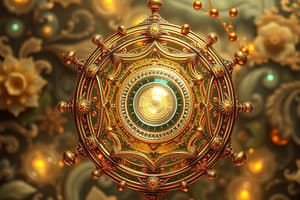Podcast
Questions and Answers
Which electron configuration is correct for Nickel when it forms a +3 ion?
Which electron configuration is correct for Nickel when it forms a +3 ion?
- [Ar] 4s2 3d8 (correct)
- [Ar] 4s1 3d8
- [Ar] 4s2 3d7
- [Ar] 4s1 3d9
Which element is an exception to the filling order and has a different electron configuration depending on whether it forms a +1 or +2 ion?
Which element is an exception to the filling order and has a different electron configuration depending on whether it forms a +1 or +2 ion?
- Cu (correct)
- He
- V
- Br
What is the correct electron configuration for Copper when it forms a +2 ion?
What is the correct electron configuration for Copper when it forms a +2 ion?
- [Ar] 4s1 3d9
- [Ar] 4s2 3d9
- [Ar] 4s1 3d10 (correct)
- [Ar] 4s2 3d8
What is the maximum number of electrons that can occupy an s orbital?
What is the maximum number of electrons that can occupy an s orbital?
Deduce the maximum number of electrons that can occupy the subshell of f orbitals.
Deduce the maximum number of electrons that can occupy the subshell of f orbitals.
Which element has an electron configuration that ends in 4p5?
Which element has an electron configuration that ends in 4p5?
What does the principal quantum number 'n' represent?
What does the principal quantum number 'n' represent?
For an electron with n = 2, what are the possible values of l?
For an electron with n = 2, what are the possible values of l?
What is the maximum number of electrons that can be described by n = 4 and l = 2?
What is the maximum number of electrons that can be described by n = 4 and l = 2?
Which set of quantum numbers represents a 'p' orbital?
Which set of quantum numbers represents a 'p' orbital?
How many total orbitals are there when n=5?
How many total orbitals are there when n=5?
Which complete set of quantum numbers represents a valence electron in an atom?
Which complete set of quantum numbers represents a valence electron in an atom?
How many electrons can occupy all of the n=3 orbitals?
How many electrons can occupy all of the n=3 orbitals?
What is the maximum number of electrons that can occupy the l=1 shell with n=4?
What is the maximum number of electrons that can occupy the l=1 shell with n=4?
What are the possible values of ml for an electron in a 3d orbital?
What are the possible values of ml for an electron in a 3d orbital?
In which subshell can an electron with n=5 and l=1 be found?
In which subshell can an electron with n=5 and l=1 be found?
What is the value of l for an electron in a 5f orbital?
What is the value of l for an electron in a 5f orbital?
How many electrons can inhabit all of the n=2 orbitals?
How many electrons can inhabit all of the n=2 orbitals?
Flashcards are hidden until you start studying
Study Notes
Electron Configurations
- Nickel (Ni) in a +3 ion has the electron configuration [Ar] 3d^7.
- Copper (Cu) in a +2 ion has the electron configuration [Ar] 3d^9.
- Silver (Ag) is an exception to the filling order, showing different configurations for +1 ([Kr] 4d^10) and +2 ([Kr] 4d^9) ions.
Electron Capacity in Orbitals
- An s orbital can hold a maximum of 2 electrons.
- The f subshell can accommodate a maximum of 14 electrons.
Atomic Identification
- The element with an electron configuration ending in 4p^5 is Bromine (Br).
Quantum Numbers
- The principal quantum number 'n' indicates the energy level and distance of an electron from the nucleus.
- For n = 2, the possible values of the azimuthal quantum number (l) are 0 and 1, corresponding to s and p orbitals, respectively.
- The maximum number of electrons for n = 4 and l = 2 (d orbitals) is 10.
Orbitals and Electrons
- A 'p' orbital is represented by the quantum numbers where l = 1.
- At n = 5, there are a total of 25 orbitals: 1s, 3p, 5d, and 7f.
- A complete set of quantum numbers representing a valence electron typically has n equal to the highest principal quantum number of the atom.
Electron Occupancy
- All n=3 orbitals can hold a maximum of 18 electrons.
- The maximum number of electrons that can occupy the l=1 shell with n=4 is 6.
- Possible values of magnetic quantum number (ml) for an electron in a 3d orbital are -2, -1, 0, +1, +2.
- An electron with n=5 and l=1 is found in the 5p subshell.
- The value of l for an electron in a 5f orbital is 3.
- All n=2 orbitals can accommodate a total of 8 electrons.
Studying That Suits You
Use AI to generate personalized quizzes and flashcards to suit your learning preferences.




